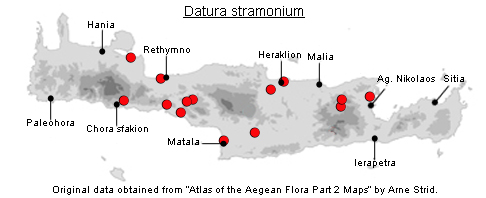
SPECIES DESCRIPTION
DATURA STRAMONIUM
Family and Genus:- See- SOLANACEAE
Common Names:- Thornapple, Jimsonweed.
Homotypic Synonyms:- Datura tatula.
Meaning:- Datura (L) From an Indian vernacular name dhartura.
Stramonium (Gr) From a name used by the Greek philosopher
Theophrastrus for the thornapple.
General description:- Large, foul-smelling, sparingly branched annual herb.
Stems:-
1) Generally 40-100 cm tall.
Leaves:-
1) 5-18(-21) x 4-15 cm, ovate to elliptical, acute, cuneate to subcordate margin
sinuate-dentate to lobed.
Flowers:-
1) Erect, infundibuliform, 50-100 mm long, solitary at the axils of the upper leaves,
sometimes in the forks of branches, short-petiolate.
2) Calyx, 30-50 mm, tubular, angled;
a) teeth, (3-)5-10 mm, unequal.
3) Corolla, twice as long as the calyx, with prominent ribs, folded and opening only
partially, white or pale lilac.
4) Stamens and style, included.
Fruit:-
1) Capsule, (2·5-)3·5-7 x (2-)3·5 cm, ovoid, erect, dehiscing, regularly, densely
covered with ± equal, rather slender spines c. 10 mm
Key features:-
1) Corolla, not more than 10 cm.
2) Capsule, erect, dehiscing regularly; with rather slender, ± equal spines not more
than 15 mm, rarely smooth.
3) Calyx-teeth, usually 5-10 mm, unequal.
Habitat:- Coastal and ruderal habitats, fallow fields, gardens, olive groves. 0-700(-
1100) m.
Distribution:- Scattered scattered throughout Greece. - Probably native to N
America. Widespread across the Mediterranean. On Crete mainly confined to the
lowland arable areas.
Flowering time:- May-Aug, (later in irrigated areas).
Photos by:- Steve Lenton
